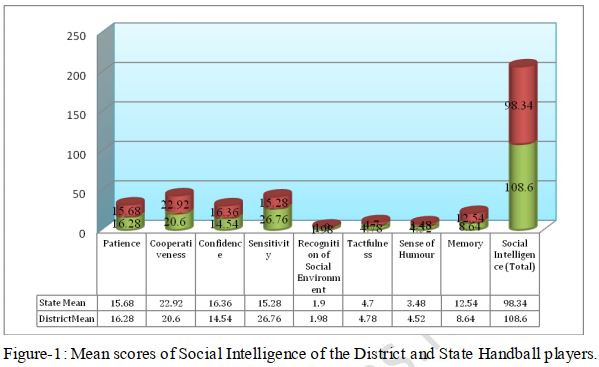A COMPRESSIVE STUDY OF SOCIAL INTELLIGENCE BETWEEN DISTRICT AND STATE LEVEL BASKETBALL PLAYERS
Abstract
The present study was focused to assess the level of Social Intelligence between District and State Level Basketball Players. A group of 30 subjects (15 district and 15 state) aged 17-25 years participated in the study. The purposive sampling technique was used to attain the objectives of the study. All the subjects, after having been informed about the objective and protocol of the study, gave their consent and volunteered to participate in this study. To measure the level of Social Intelligence the subjects, the Social Intelligence Questionnaire constructed by Chadha and Ganesan (1986) was administered. The results of Social Intelligence (i.e., Patience, Cooperativeness, Confidence, Sensitivity, Recognition of Social Environment, Tactfulness, Sense of Humour, Memory and Social Intelligence (Total) between Basketball players of district and state are presented in table-1. In case of Social Intelligence, insignificant betweengroup differences were found for all sub-variables.
Downloads
References
Cantor, N., & Kihlstrom, J.F. (1987). Personality and social intelligence. New Jersey: Englewood Cliffs, Prentice-Hall.
Goleman, D. (2007). Social intelligence: The new science of human relationships. New York: Random House.
Chadha, N.K., & Ganesan, U. (1986). Publication manual for social intelligence scale. National Psychological Corporation, 4/230, Kacheri Ghat, Agra, India.
Morgan, T.K., & Giacobbi, P.R. (2006). Toward two grounded theories of the talent development and social support process of highly successful collegiate athletes. The Sport Psychologist, 20(3), 295-313.
Thorndike, E. L. (1920). Intelligence and its uses. Harper's Magazine, 140, 227-235.
Guilford, J.P. (1958). Psychometric methods. New York: McGraw Hill.
Jones, K., & Day, J. D. (1997). Discrimination of two aspects of cognitive-social intelligence from academic intelligence. Journal of Educational Psychology, 89(3), 486-497.
Marlowe, H. A. (1986). Social intelligence: Evidence for multidimensionality and construct independence. Journal of Educational Psychology, 78(1), 52-58.
Kobe, L. M., Reiter-Palmon, R., & Rickers, J. D. (2001). Self-reported leadership experiences in relation to inventoried social and emotional intelligence. Current Psychology: Developmental, Learning, Personality and Social, 20(2), 154-163.
Cheng, C., Chiu, C., Hong, Y., & Cheung, J. S. (2001). Discriminative facility and its role in the perceived quality of interactional experiences. Journal of Personality, 69(5), 765-786.
Ford, M. E., & Tisak, M. S. (1983). A further search for social intelligence. Journal of Educational Psychology, 75(2), 196-206.
Taylor, E. H. (1990). The assessment of social intelligence. Psychotherapy, 27(3), 445-457.
Silvera, D. H., Martinussen, M., & Dahl, T. I. (2001). The tromso social intelligence scale, a self-report measure of social intelligence. Scandinavian Journal of Psychology, 42(4), 313- 319.
Parkinson, S.B. (1996). Emotions are social. British Journal of Psychology, 87(4), 663-683.















